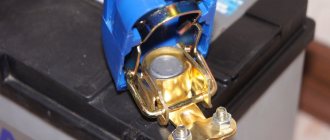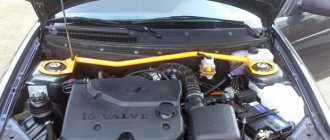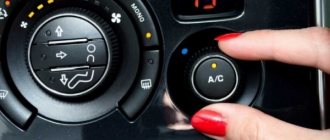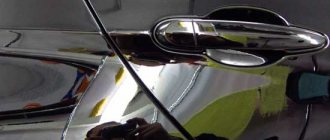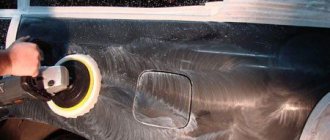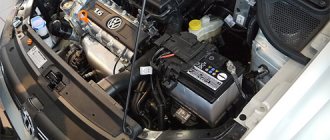Comments: one
Rating:
In the harsh conditions of our winters, one month of car operation can be equated to a year of summer driving. What suffers first of all from the famous sand-salt mixture of domestic utilities is the body of the car - its service life is significantly reduced, this equally applies to both foreign cars and domestically produced cars. Even high-quality anti-corrosion treatment carried out by the manufacturer before painting the body will not be able to reliably protect the metal from the effects of chemically active reagents that are present in any deicing agent. Even if the winter turns out to be snowless, temperature changes will still do their evil deed. It is worth worrying about the question of how to treat your car for the winter, since protective coatings will not only extend its life, but will also ensure trouble-free operation in the frosty season.
Car in winter
See also:
How to treat the underbody of a car with mastic
Preparing your car for winter
Many car enthusiasts mistakenly believe that before the winter months it is enough to do a number of procedures, which everyone probably knows about:
- replacing summer tires with winter tires, possibly equipped with studs;
- checking the condition of antifreeze in the engine cooling system;
- servicing the battery or replacing it if necessary;
- filling the windshield washer reservoir with “anti-freeze”;
- Inspection of wipers or replacing them with winter ones.
It would seem that the list is exhaustive. No, something is missing - you need to change the summer soft floor mats to rubber “troughs” with high sides and put a snow scraper in the trunk! What is forgotten in all this trouble is that your four-wheeled friend will have to experience first-hand all the delights of the effects of low temperatures, ice, snow and chemically active substances that fall so abundantly on our roads in the winter. Protection from external aggressive environments and extreme temperatures is not only necessary for your delicate skin; in winter, external parts of the machine are also tested:
- glass – susceptible to freezing both inside and outside;
- paintwork – microcracks can turn into blisters and hidden pockets of corrosion;
- side mirrors – even when equipped with a heating option, they do not always effectively provide sufficient visibility in case of heavy icing and snow accumulation;
- the bottom of the car is perhaps the most vulnerable place of your vehicle;
- the body – there is plenty of room for the winter elements to roam here: wheel arch liners, sills, aprons – all these parts are at risk;
Door, car handle covered with snow and ice
- wheel rims - a road “porridge” of ice, snow, sand, salt and chemicals quickly damages both steel parts and those made from light alloys;
- plastic elements - moisture entering technological gaps expands when freezing, which can lead to rupture of plastic connections;
- rubber seals for doors and trunk - unlike products for the chassis and engine, they have a porous structure and are able to absorb a certain amount of moisture, freezing at subzero temperatures, it can completely destroy such a gasket;
- optics - the accumulation of snow on the headlights and their icing can cause complete “blindness” of the driver - you must agree, it is completely inconvenient to stop every five hundred meters to clean the lights and turn signals;
- locks - moisture getting inside the mechanism turns into ice in cold weather, preventing the door or trunk from opening;
- internal cavities - snow, ice and water usually treacherously accumulate there, which leads to increased corrosion, which cannot be immediately detected during external inspection.
In general, our list of works turned out to be quite impressive. Don’t despair; it’s quite possible to prepare your car body for winter in a couple of days.
See also:
Which anti-corrosion agent is best for a car?
Replacing tires
High-quality winter tires are the key to your safety when driving in special winter conditions. Even with all the modern assistants installed in the car, this point is very important for properly preparing the car for winter. At low temperatures, summer tires freeze and harden, which greatly affects handling. On such tires it becomes very difficult to make any movements on the car, since when accelerating or braking there is a high risk of skidding. Therefore, using summer tires in winter is not only not advisable, but also very dangerous.
Tips for choosing winter tires:
- Car owners often mistakenly believe that all-season tires are quite suitable for winter. Typically, such a tire is marked AW (Any Weather) or AS (All Seasons). But, their seasonality is limited by the conditions of warmer and snow-free regions of Europe; they are not intended for the cold Russian winter. Therefore, for our harsh conditions, it is necessary to choose tires with the index W (Winter - Winter) or M+S (Mud+Snow - Mud + Snow). Using just such tires in winter will increase safety and make you feel more confident behind the wheel of a car.
- When choosing between studded or friction tires, you need to decide in what conditions you will use the car most often. Studded ones are suitable for mostly icy roads where there is no large, loose snow cover, and Velcro friction tires will perform well on slush and slushy snow. It is also worth noting that modern Velcro, even on ice, behave no worse than spikes.
- When “re-shoeing” it is necessary to change all the wheels on the car. Many drivers often put winter tires on only one (front or rear) axle, but this usually only gives false confidence. Significantly different wheel adhesion coefficients make the car very unstable during acceleration and braking, which can cause unpredictable skidding.
It is best to take care of winter tires in advance and purchase them according to your requirements. It’s worth changing your shoes before the onset of severe frosts, so that you don’t have to stand in a long line at the tire shop later. After replacing, do not forget about summer tires. It must be lubricated with silicone and put in a dark place.
Body protective coatings
These funds can be divided into the following groups:
- paint protection;
- anti-corrosion preparations for the underbody and fender liners;
- corrosion protectors in internal cavities.
Naturally, before treating the car body for the winter, go through a thorough wash. It is necessary to get rid of all layers of dirt and active chemicals that are present in large quantities on our asphalt concrete pavement. The presence of oils and fuel drips on body parts that are subject to treatment is also unacceptable.
Washing a car at a car wash
The bottom of the car is most exposed to external aggressive environments. To protect it, bitumen mastic is usually used. There are many options for drugs based on it. To use such a tool, a number of requirements must be met:
- after washing, the bottom of the car must be dried; mastic cannot be applied to a wet surface;
- degreasing of surfaces is mandatory - the protective layer can simply fall off from the untreated metal;
- let the mastic dry - do not leave the garage for 24 hours.
Typically this protection is applied to the bottom using a brush. Modern means allow use as a spray. In any case, you need to use a car wash before treating the underside of your car for the winter.
Pay special attention to the fender liners. Even if your car is equipped with plastic protection for these parts, this is not a 100% guarantee of complete safety. You can use the same mastic that was useful for treating the bottom. Coat the inner surfaces of the wings twice - this will be enough. The crumb rubber included in its composition, in addition to anti-corrosion properties, will add soundproofing to your car.
For the internal cavities of the body, it is best to use products with a more liquid consistency. They are poured into such areas using a spray gun. The most common remedy is Movil. They usually treat cars older than four years. The slightly unpleasant odor will go away in a few days. If your car is two to three years old, then this procedure is not mandatory. To use the product, you will have to thoroughly wash the car and dry the body with a stream of warm air.
Treating the car body with hard wax
Hard wax is highly recommended for car body treatment. Treatment with liquid wax is more cosmetic than protective. Hard wax protects the paintwork of a car well, much like an apple during long-term storage. Despite the rather high cost of the procedure, its effectiveness in winter has been proven by practice. This treatment is worth paying attention to, if only because ice does not linger on the body, drops of water flow down without stopping.
See also:
Types of car body polishes against scratches
Protective products against dirt
If the car body is pre-treated for the winter with special agents that have a dirt-repellent effect, the car can be protected from dirt. Wax or ceramic coating will help with this.
Wax
Using wax aerosols is the easiest way to preventively treat a car.
Important! Spray the product only on a clean and dry surface.
As a result of waxing, the car is covered with a thin protective film. The surface becomes completely smooth, dirt and light dust, often found in dry weather, do not stick to it.
The only drawback of this method of protecting the car’s coating is its instability to moisture. Wax is afraid of water, so after each car wash or rainfall, you will have to reapply the film.
Ceramic coating
In recent years, ceramic coating has been chosen by more and more car owners. This method of protecting the body is much more reliable and allows you to protect the vehicle’s coating from water and dirt for a long time.
Ceramics is a thick varnish coating formed by spraying liquid polymer onto areas of the body. This material hardens completely and creates an “aquarium effect”, which makes the color of the car more intense and deep.
Disadvantages of this method:
- special skills are required to apply the ceramic layer evenly;
- there must be an equipped room;
- If you turn to a professional, the service will not be cheap.
It is important to understand that the costs incurred will be recouped thanks to less frequent car washes.
Treating a car from salt
To cope with premature aging of the car coating as a result of exposure to salt, you need to maintain regular “hygiene” and use special coating products.
Your mobile first aid kit
There is no doubt that for daily use of the car in winter, you will have to create a small supply of funds, which will be partly in the car, partly at home. The home kit should include:
- a means for defrosting locks - it is sold in the form of a spray in every car store and costs mere pennies;
- warm boots - you won’t always be able to start the car quickly, sometimes it takes some time.
If you were able to open the car, then the following accessories will be useful to you inside:
- snow and ice scraper brush;
- broom - snow must be swept away;
- shovel - sometimes you have to dig out;
- spray for defrosting glass.
In order to prevent freezing of the rubber seals of the doorways and trunk lid, you should treat them with silicone in advance. This product is sold at any auto store and will protect the rubber bands from possible damage.
Spray for rubber seals
See also:
Treatment of car thresholds inside and outside
Protective compounds such as “liquid glass” or “liquid cover”.
These compositions have completely different principles of operation, but are united by the method of application. One is suitable for motorists for whom the appearance of the car is important, since “liquid glass”, in addition to its protective function (the working layer is several times thicker than that of polishes), creates the feeling of a good varnish coating. This modern development has a unique composition based on alkaline solutions of sodium silicates, which interacts at the chemical level with the car’s paintwork, forming a glass film on the surface of the body that protects the car for up to 3 years. The compound is evenly applied to the prepared car body (usually done with a sponge), and after that the surface is manually (!) polished with a soft cloth. If this procedure is done at a service center, it will cost from 6,000 rubles. “Liquid cover” is more suitable for temporary application, and is a quick-drying composition that is most similar to balloon film. It is quite easy to apply to a clean car body with a simple brush. It is better to repeat the procedure several times, then you get a denser layer that holds better and is easier to remove. This coating does not look very aesthetically pleasing, but it protects not only from stains, sand and gravel, but also from scratching by branches and bushes. At the same time, the “liquid cover” is the most affordable means for independent use - one can (enough for the bumper, part of the hood and wings) costs about 200 rubles.
Should you wash your car in winter?
With the onset of cold weather, many motorists stop visiting a car bath, citing the fact that in half an hour the car will still be dirty again. Such a decision will not lead to anything good. The fact is that the “porridge” of wet snow, sand and salt, sticking to the body, dries out and freezes tightly to it. Through microcracks in the paintwork, active reagents enter metal parts and provoke corrosion. So you need to wash your four-wheeled friend not only for hygienic reasons - you need to wash off salt deposits from the body regularly to prevent it from rotting. When visiting a car wash in winter, take into account a few tips:
- Do not use hot water - sudden temperature changes can cause glass to crack;
- pay special attention to cleaning the fender liners, they are most susceptible to clogging with road debris;
- use special car shampoos - these products effectively dissolve oil films and help get rid of heavy dirt;
- after washing is completed, the body should be dried with a stream of warm air and wiped dry;
- the door seals will need to be re-treated with silicone grease.
It is especially important to visit the car wash during the thaw period and after heavy snowfalls - at this time the body is most susceptible to attacks by chemical reagents that abound on our roads.
TEXT_LINKS
Fix problems on your car
There is an opinion that it is wrong to do painting work in autumn and winter. Like, there are still difficult months ahead and it’s better to get things going by spring and summer. In our humble opinion, we should proceed from the actual state, guided by a selective approach. If there is a dent in the fender that doesn't expose bare metal, you can really hold off on body work.
Another story - deep chips, scratches to the “iron”, pockets of corrosion. By spring, this crap, under the influence of reagents, moisture and other unfavorable factors, will probably spread even more. Millimeter-sized spots will turn into more noticeable foci; in neglected places, corrosion threatens to become through. If you don’t have the opportunity to give the car to specialists or do the work yourself at a high level of painting, then simply clean out the defects, treat with a rust converter, apply primer and touch up the paint - this is in any way better than not preventing corrosion in time.
Pay attention to the condition of the underbody, sills, wheel arches and hidden cavities. If corrosion has already appeared on them, then by spring the picture may be even less rosy.
Winter car care
To summarize, we cannot fail to mention the quality of the materials used. Attempts to save on the cost of anti-corrosion agents can lead to expensive body repairs. You should only purchase time-tested mastics from well-known brands. This way, you can eliminate the use of low-quality counterfeits and confidently protect the body of your car from the effects of aggressive winter environments. The same applies to coolant, oils and other consumables. “A stingy person pays twice, and a stupid person pays three times” - this proverb is very relevant in this case.
1 comment
- Vitya says:
The body needs to be smeared with cannon lard, my father has an endless supply at work, and it doesn’t freeze and doesn’t freeze. There is no smell, and the appearance does not deteriorate either. Although if I had a Lexus and not a Niva, I would probably cover it with something else...
Engine preparation
The first thing to do is check the engine for fluid leaks. To do this, it must be thoroughly washed and dried, then started, warmed up the engine to operating temperature and inspected to ensure there are no oil or coolant leaks. Before doing this, you should park the car on a dry area; traces of liquids will indicate problems. After checking, it is necessary to replace the oil and oil filter, as well as, if necessary, the coolant, check the condition of the wires and spark plugs, and replace the air and fuel filters. Also, in order to avoid possible problems with the fuel and injection system, it is worth draining the sediment from the fuel tank and always keeping it full when operating the car, this will save you from accumulating condensate.
And finally, the most important thing is to prepare yourself for the difficult conditions of winter roads, where you always need to adhere to the speed limit and increase the distance for safe and accident-free driving.
Complain
We protect the car body ourselves
To start work, you need to find a place without wind and dust. A garage with a dampened floor is perfect. We choose clothes without zippers and buttons on the front, so as not to scratch the machine during work. We wear safety glasses to avoid getting chemicals into your eyes.
- The first stage is quality until it is in perfect condition. Alkaline will help with a pressure washer. Our task is to remove all dirt and remnants of previous polishes from microscratches using. We thoroughly wash the body, not forgetting the wheel arches with the bottom.
- Chips down to metal, fill with soil, let dry. Then we apply it using a match, a toothpick, or a cotton swab (depending on the size of the chip).
- We clean the places where corrosion has started to bare metal and apply. We wash it off, dry it thoroughly, and then paint it in the same way as the chips.
- To restore minor scratches, we will use a wax pencil.
- We treat visible damage on the bottom.
- After all treated areas have dried, we polish the body using an electric polishing machine using wax, Teflon or silicone. The purpose of this operation is to smooth out the edges of scratches, fill microscopic scratches with a special composition to prevent the access of moisture and aggressive substances.
- We apply it - the body is ready for winter.
But what to do if you don’t have time to repair minor defects, but you still want to protect the body for the winter? In this case, after a regular wash with shampoo, we immediately use it - the car will shine like new.
Naturally, in terms of durability, such processing is inferior to professional and even garage ones. However, a positive effect is guaranteed. Dirt will not linger on your car's paintwork, and toxic deicing materials will not destroy the varnish layer.
In the harsh conditions of our winters, one month of car operation can be equated to a year of summer driving. What suffers first of all from the famous sand-salt mixture of domestic utilities is the body of the car - its service life is significantly reduced, this equally applies to both foreign cars and domestically produced cars. Even high-quality anti-corrosion treatment carried out by the manufacturer before painting the body will not be able to reliably protect the metal from the effects of chemically active reagents that are present in any deicing agent. Even if the winter turns out to be snowless, temperature changes will still do their evil deed. It is worth worrying about the question of how to treat your car for the winter, since protective coatings will not only extend its life, but will also ensure trouble-free operation in the frosty season.
Which wax is better to use for a car: liquid, solid or spray?
1. Why is processing needed? 2. Types of body wax 3. How to apply?
Using wax is an effective way to protect the car body from minor scratches and disguise existing ones. With its help, you can improve the appearance of the paintwork: add additional shine, increase the ability to repel dust and dirt. Wax can be synthetic or natural; the latter is most often of plant origin.
Externally, the substance resembles fat, the melting point is 40–90°. The main feature is the inability to react with water and alkalis. This allows you to protect the body from external influences.
How to properly clean?
To quickly and effectively wash your car from traces of midges, you must adhere to the following recommendations:
Washing with a sponge
- Carry out all manipulations after the car has cooled down. Otherwise, the effectiveness of all cleaning products is significantly reduced;
- To remove dirt from paintwork or glass, it is best to use microfiber cloths or special sponges. Hard towels may damage the paint or leave scratches;
- Do not use a blade or other sharp objects to remove stubborn stains. In this way it is very easy to damage the surface, even if your actions are very careful;
- After applying special products, they must be washed off. Aggressive substances that are included in their composition can damage the paint;
- If you were unable to wash your car from traces of midges on your own, contact a specialized car wash. They will help you with this problem for a small fee.
Types of body wax
The least commonly used wax is in spray form . It is convenient to apply, but it has low resistance to weather conditions and is quickly washed off. The liquid version is not so convenient to use, but it is more resistant to external influences and lasts longer. The substance is applied to a dry, clean surface by rubbing. The hard type is also applied in dry conditions. This is a rather complicated and time-consuming procedure. The coating lasts from one to three months, depending on how the car is used.
Natural and synthetic products are available for sale . Polish of synthetic origin is resistant to external influences, can maintain the effect for up to 6 months, and is usually sold in liquid form. Sometimes the substance is added to car shampoos, since it can be applied to a wet surface.
Product classification according to application technology:
- Cold wax is available in liquid form. The composition includes cationic active substances and emulsion wax. The coating can be applied manually. It will need to be updated after every wash or after the car gets exposed to rain.
- Hot wax comes in the form of a fat-like substance and can be natural or artificial. The coating melts at 90 °C. The highest quality is carnauba wax. It is resistant to wear, has a high melting point, and is transparent. The substance can stay on the body for up to six months and does not require renewal after washing. Many companies produce products that include corrosion inhibitors. Hot wax is harmless to a car; processing with it is safe for polished surfaces. It’s easy to understand how to apply cold wax, but with hot wax there may be some difficulties. Application occurs after diluting the substance with heated water. Then it is distributed over the body of the machine using a sponge. The downside is the high price.
- The third type is foam wax. Its difference from other materials is its special application technology. Special equipment is required that can direct foam under pressure. Such equipment is usually available only at sinks, so this type is most often not used at home. Polishing occurs by creating a foam emulsion. The equipment pumps air, mixes it with water and wax, and shoots it onto the car body. Thanks to high pressure, polishing occurs when the emulsion and the surface of the car collide.
Stage two. Body cleaning
While driving along our wonderful roads, the body, in addition to ordinary dirt, is covered with many accompanying elements of the periodic table, and in the summer also with insects. To clean the MarkII body we used the most basic cleaner Profoam 5000.
Apply the product to the washed body, to areas of contamination that have not been removed with water and shampoo. It is necessary to allow the product to absorb and break down the dirt, then remove the product with a damp cloth.
In this case, we did not use the strongest body cleaner. But if the car was seriously damaged by tar during the spring aggravation of road services, then I recommend using Tar-Pitchclener.
Using more powerful cleaners, such as Profoam 1000 (for engine) and Profam 2000 (universal cleaner), you risk damaging the paintwork by dissolving the paint. Also beware of fakes. The original products are produced under the Kangaroo brand.
A special recommendation - wear rubber gloves! I myself boldly started without them, so I know what I’m talking about - after two minutes I felt the entire chemical composition of the cleanser on my skin and ran for gloves.
Removing chips
Continuing the topic of the realities of Russian roads, I would like to note that not a single car, even a little used one, avoids paint chips, with which something must be done. Indeed, in addition to deteriorating the appearance, chips lead to corrosion and further peeling of paint from the body. The company Soft99 comes to the aid of motorists, producing an analogue of factory paint in convenient tubes with brushes.
As a result, we have less noticeable damage to the body. It should be noted that the use of such paint is only a temporary masking of the problem; the issue will be completely resolved only by professional painting of the body.
Removing chips - read the detailed instructions.
Types of liquid wax
Which car wax is best?
In order to answer this question, you need to know what modern wax coatings are? The question is quite ambiguous for the reason that there are three types of waxes: Cold car wax , as a rule, is a liquid containing a large amount of cationic surfactants (surfactants) and emulsion wax. When applied, it fills microcracks, irregularities, scratches, creating a protective layer and adding shine to the coating. This coating makes car washing easier and speeds up drying. This wax is applied and polished by hand. The disadvantage of these types of waxes is their relative fragility. For the best effect, it is advisable to use them after every one or two washes.
Hot car wax is a fat-like substance that can be either artificial or natural. Its melting point ranges from forty to ninety degrees. Waxes from renowned manufacturers most often use carnauba wax, which has complete transparency, a high melting point and is highly resistant to wear. It is believed that this type of wax retains its protective properties for six to twelve months. When applied, it is diluted with hot water in appropriate proportions and applied with a sponge or cloth and polished. Corrosion inhibitors are often added to hot waxes, stopping the corresponding processes in the metal of the car body. Due to the use of rather expensive raw materials in hot waxes, their cost is also quite high.
Foam waxes have properties similar to hot waxes. To apply this type of wax, special equipment is required due to the fact that air is supplied to the mixture of water and wax composition, thus creating a foam emulsion, which, when applied to the surface of the car, is better retained on it and polishes more evenly.
Regular car waxing will keep your car in good condition for a long time.
